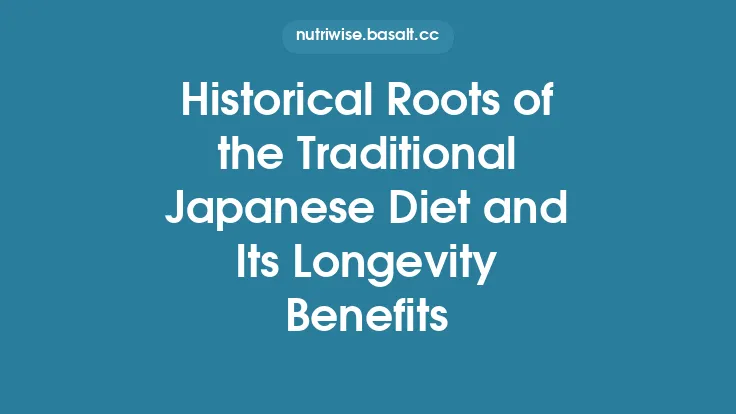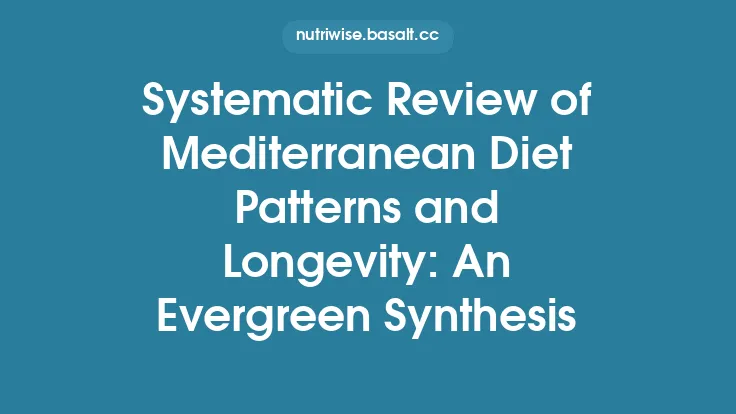The Mediterranean diet has endured for centuries, not merely as a culinary tradition but as a model of sustainable, health‑promoting eating. Its appeal lies in a harmonious blend of food choices, cultural practices, and lifestyle habits that together create a resilient dietary pattern. Below, we explore the timeless elements that underpin its popularity, drawing on historical context, nutritional science, and practical guidance for modern adoption.
Historical Roots and Cultural Context
The Mediterranean basin—spanning Southern Europe, North Africa, and the Near East—has long been a crossroads of trade, migration, and agricultural innovation. Several key historical factors have shaped the diet we recognize today:
- Agricultural Diversity: The region’s varied climate supports olives, grapes, wheat, legumes, and a wide array of fruits and vegetables. This biodiversity fostered a diet rich in plant‑based foods long before modern nutrition science.
- Trade Routes: Ancient trade introduced spices, nuts, and dried fruits, enriching the palate and encouraging the use of flavor‑enhancing ingredients without relying on excessive salt or animal fat.
- Social Eating: Meals traditionally served as communal events, emphasizing fresh, seasonal produce and modest portions of animal products. This social dimension reinforced mindful eating and portion control.
These cultural foundations created a dietary pattern that is both adaptable to local resources and resilient across generations.
Core Food Components
At the heart of the Mediterranean diet are a handful of food groups that appear consistently across the region’s cuisines:
| Food Group | Typical Sources | Role in the Diet |
|---|---|---|
| Olive Oil | Extra‑virgin olive oil, olives | Primary source of monounsaturated fats; provides phenolic antioxidants that protect cellular membranes. |
| Whole Grains | Whole‑wheat bread, barley, farro, couscous | Supply complex carbohydrates, fiber, B‑vitamins, and minerals such as magnesium and selenium. |
| Legumes | Chickpeas, lentils, beans, peas | Offer plant‑based protein, soluble fiber, and micronutrients (iron, folate). |
| Fruits & Vegetables | Tomatoes, leafy greens, citrus, berries, eggplant, peppers | Rich in vitamins, minerals, phytochemicals (e.g., lycopene, flavonoids) and dietary fiber. |
| Nuts & Seeds | Almonds, walnuts, pine nuts, sesame | Provide healthy fats, protein, and trace minerals (copper, manganese). |
| Fish & Seafood | Sardines, salmon, mackerel, shellfish | High in omega‑3 fatty acids (EPA/DHA), vitamin D, and iodine. |
| Dairy (moderate) | Yogurt, cheese (e.g., feta, pecorino) | Contribute calcium, probiotics, and protein, typically consumed in modest portions. |
| Herbs & Spices | Basil, oregano, rosemary, garlic, cumin | Enhance flavor without added sodium; many possess anti‑inflammatory properties. |
| Wine (optional) | Red wine, consumed in moderation | Provides polyphenols such as resveratrol; benefits are dose‑dependent. |
The diet’s emphasis on minimally processed, whole foods ensures a high nutrient density while limiting added sugars, refined grains, and saturated fats.
Nutrient Profile and Health Benefits
1. Fat Quality
- Monounsaturated Fatty Acids (MUFA): Predominantly from olive oil, MUFAs improve lipid profiles by lowering LDL‑cholesterol and maintaining HDL‑cholesterol.
- Polyunsaturated Fatty Acids (PUFA): Omega‑3s from fatty fish reduce triglycerides and exert anti‑inflammatory effects.
2. Fiber and Micronutrients
- Soluble Fiber (from legumes, oats, fruits) binds bile acids, aiding cholesterol excretion.
- Antioxidants (vitamin C, E, carotenoids, polyphenols) combat oxidative stress, a driver of chronic disease.
3. Protein Sources
- Plant‑Based Proteins: Legumes and nuts provide essential amino acids with lower saturated fat.
- Lean Animal Proteins: Fish and modest poultry portions supply high‑quality protein and micronutrients without excessive saturated fat.
4. Glycemic Control
- The combination of low‑glycemic carbohydrates, fiber, and healthy fats moderates post‑prandial glucose spikes, supporting insulin sensitivity.
Collectively, these nutrient characteristics have been linked to reduced risk of cardiovascular disease, certain cancers, type‑2 diabetes, and neurodegenerative conditions.
Scientific Evidence Supporting Longevity
Large‑scale epidemiological studies and randomized controlled trials (RCTs) have repeatedly demonstrated the Mediterranean diet’s protective effects:
- PREDIMED Trial (Spain, 2013): Participants assigned to a Mediterranean diet enriched with extra‑virgin olive oil or nuts experienced a 30% reduction in major cardiovascular events compared with a low‑fat control group.
- EPIC Study (Europe, 2015): Higher adherence correlated with lower all‑cause mortality and reduced incidence of colorectal cancer.
- Meta‑Analyses (2020‑2023): Consolidated data from over 30 cohort studies show a consistent 20‑25% decrease in risk for coronary heart disease and a 15% reduction in stroke incidence among high adherents.
These findings underscore that the diet’s benefits are not limited to short‑term weight management but extend to long‑term health and lifespan.
Culinary Patterns and Lifestyle Factors
Meal Structure
- Breakfast: Often light—whole‑grain toast, fruit, yogurt, or a small portion of nuts.
- Lunch: Typically the largest meal, featuring a vegetable‑rich salad, whole grains, legumes, and a modest portion of fish or poultry.
- Dinner: Similar to lunch but lighter; may consist of a vegetable stew, a small serving of cheese, and whole‑grain bread.
Cooking Techniques
- Sautéing & Grilling: Use olive oil or minimal oil, preserving nutrients while adding flavor.
- Stewing & Roasting: Slow cooking of vegetables and legumes enhances digestibility and nutrient availability.
- Raw Consumption: Fresh salads and fruit provide maximal vitamin content.
Physical Activity & Social Interaction
- Regular, moderate physical activity (e.g., walking, gardening) is culturally embedded.
- Shared meals encourage mindful eating, slower consumption, and better satiety cues.
These non‑nutritional components reinforce the diet’s effectiveness by fostering a holistic approach to health.
Practical Implementation and Adaptation
Building a Mediterranean Pantry
- Fats: Stock extra‑virgin olive oil, olives, and a variety of nuts.
- Grains: Choose whole‑grain breads, brown rice, bulgur, and whole‑wheat pasta.
- Legumes: Keep canned or dried beans, lentils, and chickpeas on hand.
- Produce: Prioritize seasonal fruits and vegetables; frozen options retain nutrients.
- Fish: Aim for two servings per week of fatty fish; use canned sardines or salmon for convenience.
- Herbs & Spices: Fresh basil, oregano, rosemary, and garlic are staples.
Meal Planning Tips
- Batch Cook: Prepare large pots of beans or lentil soup to use throughout the week.
- One‑Pan Dishes: Combine vegetables, whole grains, and a protein source with olive oil for quick, balanced meals.
- Portion Guidance: Fill half the plate with vegetables, a quarter with whole grains, and a quarter with protein (preferably fish or legumes).
- Mindful Snacking: Opt for a handful of nuts, a piece of fruit, or yogurt with honey.
Adapting to Different Dietary Needs
- Gluten‑Free: Substitute wheat‑based grains with quinoa, millet, or certified gluten‑free pasta.
- Low‑Sodium: Use herbs, citrus zest, and vinegar to flavor dishes instead of salt.
- Vegetarian/Vegan: Emphasize legumes, nuts, seeds, and plant‑based dairy alternatives while maintaining the core principles of olive‑oil‑based cooking.
Common Misconceptions
| Misconception | Clarification |
|---|---|
| “The diet is high‑fat and therefore unhealthy.” | The fat is primarily monounsaturated and polyunsaturated, which are cardioprotective. |
| “You must eat fish every day.” | Two servings per week are sufficient; plant‑based omega‑3 sources (e.g., walnuts, flaxseed) can complement intake. |
| “Mediterranean meals are expensive.” | Seasonal produce, legumes, and whole grains are cost‑effective; olive oil, though initially pricey, lasts long due to its stability. |
| “Wine is required for the health benefits.” | Moderate wine consumption is optional; the diet’s benefits persist without alcohol. |
| “It’s a restrictive diet.” | The pattern is flexible, allowing for a wide variety of foods and cultural adaptations. |
Understanding these nuances helps prevent oversimplification and promotes realistic, sustainable adoption.
Looking Ahead: The Mediterranean Model as a Blueprint
The Mediterranean diet’s longevity stems from its integration of nutrient‑dense foods, cultural practices, and lifestyle habits that collectively support health across the lifespan. As nutrition science evolves, the core principles—emphasis on plant foods, healthy fats, moderate animal protein, and social eating—remain relevant and adaptable to diverse populations.
By focusing on whole, minimally processed ingredients, encouraging regular physical activity, and fostering communal meals, the Mediterranean model offers a timeless framework for anyone seeking a balanced, evidence‑based approach to nutrition. Its enduring popularity is not a fleeting fad but a testament to a dietary philosophy that aligns with both human biology and cultural well‑being.





